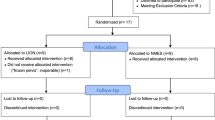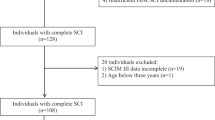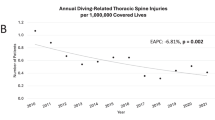Abstract
Study design:
Retrospective study.
Objective:
To describe the pattern and outcome of spinal cord injuries in Lagos, Nigeria.
Setting:
Nigeria, Lagos.
Methods:
This retrospective review of cases was conducted at Lagos University Teaching Hospital (LUTH), Lagos, between January 1992 and December 2006.
Results:
A total of 468 cases of spinal cord injury over the 15-year period were studied. Three hundred and twelve of them (66.2%) were aged 40 years and below, with the peak age incidence as 21–30 years. There were 328 males (70.1%) and 140 females (29.9%) showing a male to female ratio of 2.34:1. Road traffic accident accounted for 362 (77.4%) patients. At presentation, 430 (91.9%) of the injuries were of ASIA (American Spinal Injury Association) class A. Lumbar spine was affected in 278 (59.4%) of patients, whereas cervical spine accounted for 142 (30.3%). The most frequently seen complication was bedsore, seen in 163 (59.9%) of 272 patients that had complications. On discharge, 230 patients (49.1%) were in ASIA class A and 34 (7.5%) in ASIA E. Eighty-two patients (17.5%) died.
Conclusion:
Spinal injuries in Lagos occurred mostly in young adult males affecting mainly the lumbar spine. Traffic-related incidents were the leading cause and bedsore the most common complication.
Similar content being viewed by others
Log in or create a free account to read this content
Gain free access to this article, as well as selected content from this journal and more on nature.com
or
References
DeVivo MJ . Epidemiology of traumatic spinal cord injury. In Kivshblums et al (eds). Spinal Cord Medicine, Vol 1 Lippincort Williams and Wilkins: Baltimore, 2002 pp 69–81.
British Trauma Society. Guideline for initial management and assessment of spinal cord injury. 2003; 34: 405–425.
Price C, Makintubee S, Herndon W, Istre GR . Epidemiology of traumatic spinal cord injury and acute hospitalization and rehabilitation charges for spinal cord injuries in Oklahoma, 1988–1990. Am J Epidemiol 1994; 139: 37–47.
DeVivo MJ, Ruth RD, Black KJ . Trends in spinal cord injury demographics and treatment outcomes between 1973–1986. Arch phys med rehabil 1992; 73: 424–430.
Agarwal P, Upadhvav P, Raja K . A demographic profile of traumatic and non-traumatic spinal injury cases: a hospital-based study from India. Spinal Cord 2007; 45: 597–602.
Chen HY, Chiu WT, Chen SS, Lee LS, Hung CI, Hung CL et al. A nationwide epidemiological study of spinal cord injuries in Taiwan from July 1992–June 1996. Neurol Res 1997; 19: 617–622.
Green D . Diagnosis, prevalence and management of spinal cord injury. J spinal cord med 2003; 26: 329–334.
Priebe MM, Waring WP . The interobserver reliability of revised American spinal injury association standards for neurological classification of spinal injury patients. AmJ phys med rehabil 1991; 70: 266–270.
Karamehmetoglu SS, Nas K, Karacan I, Sarac AJ, Koyuncu H, Ataoglu S et al. Traumatic spinal cord injuries in southeast Turkey: an epidemiological study. Spinal Cord 1997; 35: 531–533.
Solagberu BA . Spinal Cord injuries in Ilorin, Nigeria. West Afr Med 2002; 21: 230–232.
Nwankwo OE, Kachy AU . Outcome of a 12-week programme for management of the spinal cord injured with participation of patient's relation at Hiltop orthopaedic hospital, Enugu, Nigeria. Spinal Cord 2003; 41: 129–133.
Leonard M, Sproule J, Mc Cormack D . Paediatric spinal trauma and associated injuries. Injury 2007; 38: 188–193.
O'Connor P . Injury to the spinal cord in motor vehicle traffic crashes. Accid Anal Prev 2002; 34: 477–485.
American spinal injury association. International Standards for Neurological Classification of Spinal Cord Injury (revised). American spinal injury association: Chicago, 2000, 1–23.
DeVivo MJ . Causes and costs of spinal cord injury in the United States. Spinal Cord 1997; 35: 809–813.
Windrope J, Ravischandran G, Locker T . Risk assessment for spinal injury after trauma. BMJ 2004; 328: 721–723.
O'Connor PJ . Development and utilisation of the Australian spinal cord injury register. Spinal Cord 2000; 38: 597–603.
O'Connor PJ . Survival after spinal cord injury in Australia. Arch Phys Med Rehabil 2005; 86: 37–47.
O'Connor PJ . Forecasting of spinal cord injury annual case numbers in Australia. Arch Phys Med Rehabil 2005; 86: 48–51.
O'Connor PJ . Trends in spinal cord injury. Accid Anal Prev 2006; 38: 71–77.
Author information
Authors and Affiliations
Corresponding author
Rights and permissions
About this article
Cite this article
Obalum, D., Giwa, S., Adekoya-Cole, T. et al. Profile of spinal injuries in Lagos, Nigeria. Spinal Cord 47, 134–137 (2009). https://doi.org/10.1038/sc.2008.93
Received:
Revised:
Accepted:
Published:
Issue date:
DOI: https://doi.org/10.1038/sc.2008.93
Keywords
This article is cited by
-
Epidemiology and clinical outcomes of spinal cord injuries at a level II trauma centre in Nigeria: a longitudinal five year study
International Orthopaedics (2021)
-
Nonoperative treatment of traumatic spinal injuries in Tanzania: who is not undergoing surgery and why?
Spinal Cord (2020)
-
Demographic and clinical characteristics of individuals with traumatic spinal cord injury in Argentina from 2015 to 2019: a multicenter study
Spinal Cord Series and Cases (2020)
-
International Standards for Neurological Classification of Spinal Cord Injury: factors influencing the frequency, completion and accuracy of documentation of neurology for patients with traumatic spinal cord injuries
European Journal of Orthopaedic Surgery & Traumatology (2019)
-
Outcomes after acute traumatic spinal cord injury in Botswana: from admission to discharge
Spinal Cord (2017)



